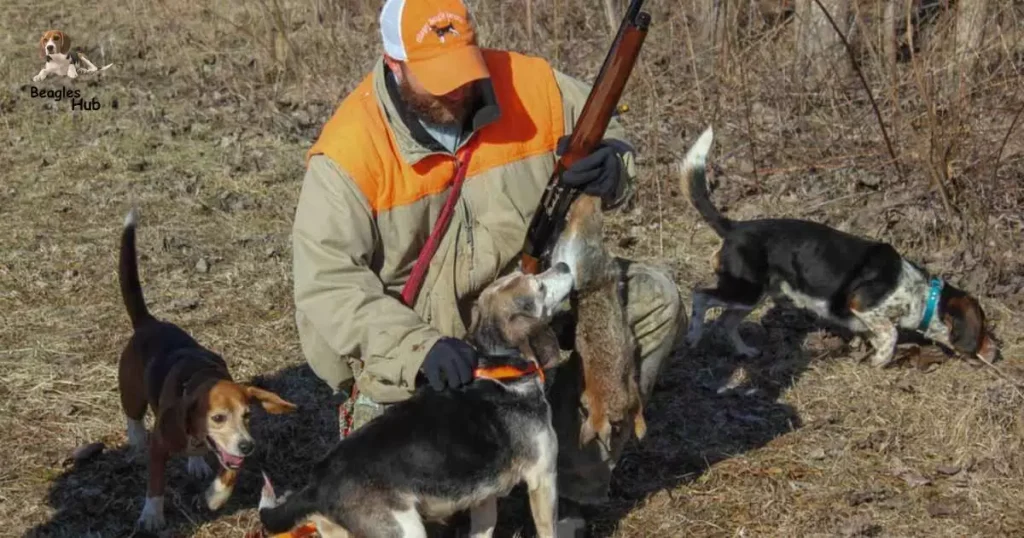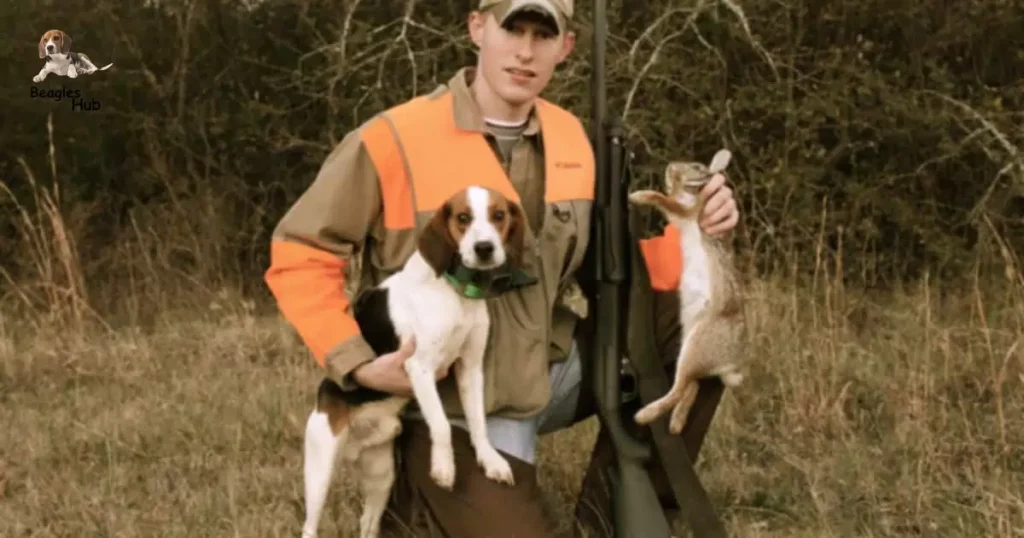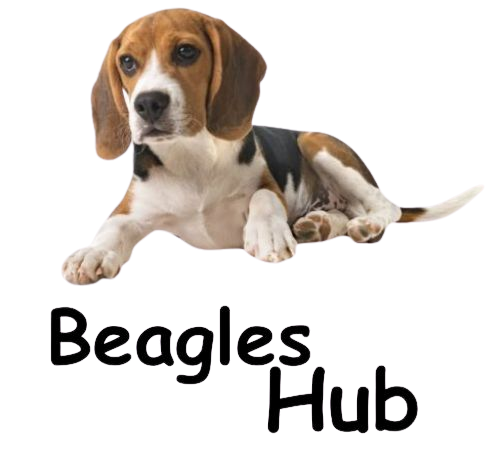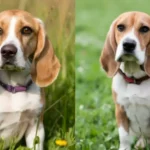Training a beagle for rabbit hunting requires time, patience and an understanding of the breed’s natural instincts. Beagles have an incredibly strong prey drive coupled with a determination to follow scents. Channeling these traits effectively is the key to developing a successful hunting hound.
| Tip | Description |
| Start Early | Begin training your Beagle to hunt as early as possible, ideally around 6 months of age when their prey drive starts to develop. |
| Encourage the Prey Drive | Use toys, lures, and simulated hunting scenarios to tap into your Beagle’s natural hunting instincts and build their prey drive. |
| Introduce Scent Training | Teach your Beagle to follow and track scents using treats, scented toys, or even live trails left by small game. |
| Practice Recall | A reliable recall command is crucial for hunting dogs. Train your Beagle to come when called, even when distracted by prey. |
| Use Positive Reinforcement | Reward desired behaviors with treats, praise, and affection. Avoid harsh punishments that can damage your Beagle’s confidence. |
| Hunt with an Experienced Dog | Let your Beagle observe and learn from an experienced hunting dog in the field. This can help reinforce proper technique. |
| Start with Smaller Game | Begin with small, slower prey like rabbits before moving on to faster game like hares or foxes. |
| Introduce Gunfire Gradually | Acclimate your Beagle to the sound of gunfire by gradually exposing them to recorded gunshot noises during training. |
| Be Patient | Hunting is a complex skill that takes time and consistency to develop. Be patient and keep training sessions positive and enjoyable. |
| Consider a Hunting Club | Joining a local hunting club or group can provide access to experienced trainers, hunting grounds, and ongoing support. |
Training Beagles – Prepare the Dog
The first step in beagle training for rabbit hunting is ensuring your puppy or dog has the proper foundation. Basic obedience training and exposure to sights, sounds and experiences they will encounter when hunting are critical.
Socialization to people, other dogs and new environments will help minimize distractions when your beagle is focused on the scent of a rabbit. Lifting puppies to examine them frequently, handling their paws and accustomed them to having items placed in their mouth lays groundwork for later veterinary exams and retrieving.
Expose your beagle to the types of noises they will hear when in the field hunting, like gunshots. Use recorded sounds or a starter pistol with blanks to get them comfortable with loud gunshot sounds at a distance. This prevents developing a fear or nervous reaction that could hinder their hunting effectiveness.
Some hunters recommend letting young dogs view rabbits in cages or enclosures to simply become accustomed to their sight and scent before real rabbit training sessions begin further developing their scent recognition abilities.
When to Begin Training

Most experts recommend starting structured beagle training when your puppy reaches 4-6 months of age. This allows time for basic obedience and socialization but gets them learning scent tracking fundamentals before bad habits can set in.
The early months are ideal for laying the groundwork. Then training becomes more focused on actual rabbit hunting scenarios as they mature.
Training Your Beagle for Rabbit Hunting: Starting from a Young Age
Beginning beagle puppy training for rabbit hunting at a young age taps into their natural instincts around this scent and prey. The earlier good habits are reinforced the better.
Initially, simple games tracking their favorite toy or a food treat are useful starting points. Let them “find” the item based on its scent then reward them with enthusiastic praise or letting them consume the treat. These are baby steps yet important for showing the desired result of latching onto a particular smell then tracking it to the source.
Rabbit Hunting Training for Puppies: Essential Obedience Commands

Early puppy training should also incorporate basic obedience cues that aid rabbit hunting later. Mastering commands like “come”, “sit/stay” and “no” are incredibly useful when they are tracking prey.
- The recall command “here!” or “come” brings them back rather than endlessly pursuing a scent trail not leading to an actual rabbit.
- “Sit” and “stay” prevents wandering off as you get them settled into position at the start of a hunt.
- “No” stops them from acting on sight-based instincts to immediately chase after spotting movement. This avoids flushing out the rabbits versus methodically tracking to pinpoint their location.
- Reinforcing these staple cues consistently creates control allowing them to hunt most effectively later on.
Using a Training Collar
An e-collar or remote electronic collar is almost essential gear for serious rabbit hunting dogs. Top models from Garmin and SportDOG have adjustable stimulation levels allowing you to “tap” their attention if they start ignoring commands when hot on a scent. This immediate redirection refocuses them without breaking their drive.
Respected beagle hunting guides strongly advise introducing e-collars during early leash training walks, well before relying on it to compliance mid-hunt. Letting them associate the stimulation with your other vocal commands teaches the desired response.
SportDOG’s HoundHunter series represents quality collar systems designed for the demands of hound hunting. They have multiple mile ranges with GPS dog tracking capabilities allowing you to monitor their location if they fail to return while intensely tracking rabbits.
Garmin offers similar GPS dog tracking collars purpose-built for hunting hounds. Their PRO Series models also include helpful training features like automatic correction of barking to quiet a pup still learning when to give voice.
Investing in reliable, versatile collars designed for serious rabbit hunting dogs enables more productive training and safer, successful hunts.
Training Your Beagle for Rabbit Hunting: Developing His Nose, Introducing Scent and Tracking Techniques
Beagles are hardwired for scent tracking yet practice honing this innate skill reaps rewards. Take advantage of their early engagement and energy by creating mock trails emulating those left by rabbits.
Draw lines in soil or turf then guide them leashed alongside the path as encouragement. Treat each completion as a big win praising them heavily.
Increase difficulty slowly by crisscrossing lines, making sharp turns and surface changes along with interspersing other animal scents. Mimic rabbits’ tendency to zigzag and suddenly bolt in different directions without warning.
Hide treats and safe chew toys in brush letting them sniff out items they love finding. These mini “hunts” reinforce using their nose while scratching their scent oriented instincts.
Utilize real or artificial rabbit scent attractants on these practice tracks. Encourage them to identify and associate this particular smell with their genetically predisposed prey drive triggered by specific compounds found in rabbit urine, fur and gland secretions.
These building block lessons nurture nose ability, focus and interpret early signals preparing for times they’ll need to pinpoint actual nearby rabbits versus indistinct ambient smells in the countryside.
Independent Training
As their capabilities advance it becomes useful to have hunting partners, friends or family conduct these practice drills without you present so the beagle grows accustomed to tracking with various people. Independent training gives confidence to perform whether solo, beside their owner or amidst a pack at field trials.
Retrieving
While most successful rabbit hunting beagles are experts at locating and chasing rabbits yet struggle with reliably bringing back downed prey, don’t neglect at least attempting retrieving exercises. Some individual dogs do display natural talent if positively reinforced.
Should your hound make steady progress fetching items prompted only with praise, consider formalizing retrieval cues with a special toy or training bumper exclusively used for this activity to signal “fetch it!” time.
Demonstrate enthusiasm whenever they return the object to your hand. Let them hold it briefly before gently taking it as their reward. Progress from ground level items to gently tossing it distances commensurate with their demonstrated skill at release and delivery.
If they show little natural retrieving tendency don’t force it. While nice having a dog hand you shot rabbits, most beagles simply lack this soft-mouthed willingness common among spaniels, retrievers and pointers. Keep them focused on efficient tracking, chasing and cornering abilities playing to genetic strengths.
Training Beagles – Go Slow
A common mistake is pushing beagles too aggressively into complex rabbit hunting training before truly mastering basics. Have patience confirming each step rather than rushing timelines because they seem ready for more advanced lessons.
Despite appearing eager by nature, beagles can sour on training that advances too quickly. Keep early months focused on positive reinforcement around fundamental obedience, exposure to sights and sounds soon faced hunting while gradually layering in scent recognition foundations.
The frenzied prey drive of many beagles coupled with stubborn determination requires going slow acclimating them to procedures supporting productive hunts.
Other Key Factors in Training Your Beagle for Successful Rabbit Hunting
Beyond formal obedience and tracking practice, several additional considerations influence successfully fielding your beagle. Attending to these areas ensures they reliably perform when actively hunting rabbits as part of a pack or solo with their owner.
1. Minimizing Distractions
Beagles driven by scent and sight of potential prey can be notoriously single-minded. Minimizing distractions for your dog during initial solo training and later active hunts improves response to control cues if they start intensely trailing a promising rabbit scent.
Practice in environments with limited activity and unfamiliar animals. Correct them quickly ignoring commands and return focus to the mock trail or drill at hand.
Use an electronic collar to “tap” their attention if needed as a last resort. But first exhaust positive reinforcement keeping them tuned into hunting tasks, not wandering off on tangents despite intriguing smells tempting their powerful noses!
2. Chasing Rabbits
Curbing the instinct to immediately chase spotted rabbits before being dispatched to trail by the hunter is difficult yet vital lesson. Caution them to hold position while leashed, only releasing upon hearing “get it!” or another launch command.
Use their name, the word “no” plus collar stimulation if required to restrain the sight-triggered impulse until directed. This prevents putting rabbits on high alert prematurely versus patiently circling to pinpoint locations using scent tracking capabilities only beagles possess.
3. Training Beagles – Solo Time: Get Your Beagle Around Trained Beagles
While much training occurs solo with their owner or trainer, beagles benefit from group exposure to seasoned packs demonstrating proper hunting behaviors. Arranging joint sessions, play dates with hunting friends’ dogs or attending field trials provides this perk.
Integrating young beagles into veteran groups mentors through peer modeling. They observe firsthand proper response to hunter cues, coordinated tracking, cornering and adjusting coverage when rabbits attempt escape tactics.
Controlled introduction to unfamiliar hounds prevents littermates from fixating only on each other, a common problem derailing their individual development. But go slow adding new dogs into training scenarios if your beagle seems stressed or aggressive to other canines. Solo work could be their ideal path to becoming steady hunters.
4. Gradually Introducing Other Dogs
If able to integrate additional dogs, begin by pairing your trainee beagle only with another even-tempered, experienced hound first. Observe closely their interactions before allowing the rookie access to bigger packs with multiple new dogs.
This minimizes risk of your young dog becoming overwhelmed trying to interpret multiple behaviors from a large, unfamiliar group. Adding seasoned members gradually lets them build confidence through positive early meetings.
5. Hunting in Thick Cover
Beagles excel at tracking rabbits even through dense underbrush and terrain with their low profile build and supreme scenting abilities. But still acclimate them to moving through thick wooded, brushy areas they’ll invariably encounter pursuing speedy rabbits.
Allow them to navigate logs, small streams, prickly patches and varied ground cover off-leash without pressure to track by scent. Simply monitoring their comfort crossing obstacles prepares for punishing chase conditions once actively on a rabbit’s trail.
Use these exposure outings to gauge your beagle’s willingness pushing through tough elements or determining if they are better suited for gentler hunting grounds without extreme density. Match terrain to their temperament so conditions don’t deter their chase.
Training Beagles – Redirect When Necessary
Despite best efforts some young beagles inevitably still stray from their hunting purpose on first real-world rabbit tracks. Thorough training limits wandering but the sublime scent and sight of actual nearby prey can erode lessons quickly.
In these cases calmly bring them back to the task at hand without scolding their distraction. Reissue your last command prompting correct behavior as encouragement versus frustration at temporary lapses.
Progress will surely ebb and flow with beagles yet responding with patience and positivity prevents setbacks becoming permanent bad habits.
Tackle Some Basic Obedience Training First
It’s tempting to skip directly to specialized rabbit hunting training with eager young beagle pups yet ensuring basic behavioral competence pays dividends down the road.
Don’t rush scent tracking exercises before cementing vital obedience cues like their name recognition plus “come”, “down” and “no”. These commands establish who is directing the action so they respond reliably amidst high distraction chase environments.
Set the stage for superior hunting performance by prioritizing fundamental instruction they can successfully execute before fun field drills.
Short Repetitive Training: Short and Often
Beagles notoriously have short attention spans, high energy and tendency to stubbornness. This mixture demands creative engagement to achieve results without burning out dogs or trainer.
Limit early training sessions to 10-15 minutes maximum. Better still break skill building into mini-blocks of just a few minutes randomly inserted during patio play, walks and downtime.
Frequent reinforcement even in tiny bites makes more impact than occasional lengthy lessons with puppies. Their activity levels peak in short bursts rather than extended concentration drills. Meet them on their terms by rewarding effort then letting them unwind and process before the next rep.
One-on-One Training
While beagles ultimately hunt in packs or alongside other canines, initial education works best in dedicated solo sessions with their handler.
Distraction from competition for attention spans, toys and treats hampers a clear understanding of expectations and stimuli/response goals. Bond deeply with the individual dog first cementing their respect and desire to please you.
Once leadership is established expand to group training contexts with other experienced dogs demonstrating proper protocols. Their individual foundation strengthens overall field performance.
Training Beagles – Be Patient
Breeders inevitably repeat “be patient!” to new beagle owners yet still we underestimate their spirited, mischievous nature when embarking on hunting dog education. They demand creative engagement and consistency that tests even seasoned handlers.
Rather than reprimand “bad” behaviors take a deep breath recognizing their physical needs differ from many Retrievers or Spaniels. They have below average obedience aptitude but astounding scent ability so train accordingly.
Make lessons fun games instead of rigid drills. If they lose interest quickly revert to another activity before ending on a high note. They’ll connect progress to pleasure choosing to participate.
Accept a Dog’s Weaknesses
Concentrate developing a beagle’s super sniffing specialty not mediocre attributes. They tend to have difficulty with steadiness, attention span, human bonding and control. Harping on weaknesses backfires, exacerbating problems.
While spans of careful obedience work establishes basics ultimately accept chasing scent trails not immediate compliance is a beagle’s purpose. Confine expectations to your individual dog’s realistic capabilities without overextending requests causing anxiety refusing directions.
Not every beagle succeeds as a hunting dog. Seek those bred from field champion lineages purposefully developed for scent trailing if serious rabbit hunting is the goal. Certain pups better suit family pets without stringent performance demands.
Training Beagles – Reward Results

Like most canines beagles thrive on positive reinforcement. When training leverage their food drive and praise cravings rewarding even small successes rather than scoldings for normal subpar showings.
Let them discover it’s more fun “playing the game” correctly with toys, treats and bonding time than being disciplined. Motivate the desired behavior by getting excited when they demonstrate a concept.
ProgressTracking collars
Garmin
Frequently Asked Questions
How long does it take to train a beagle to hunt rabbits?
It typically takes 4-6 months of consistent training to prepare a beagle puppy for actual rabbit hunting depending on how often you practice and their breeding. Start with short positive sessions on basic commands and scent exposure. Around 6 months of age focus more on rabbit specific hunting skills in the field.
What age should you start training a beagle to hunt?
Start beagle obedience and socialization as early as 8 weeks when adopting them. But begin formal hunting training at 4-6 months allowing time for puppy basics yet capturing their prime scent tracking learning stage before problem behaviors develop.
Should I use an electronic collar to train my beagle?
Yes, an electronic or e-collar is highly recommended for giving corrections when needed on rabbit hunts. Introduce low level stimulation paired with commands during early leash training so they learn how to respond correctly. E-collars reinforce rather than replace verbal direction. Models from Garmin and SportDOG offer adjustable, humane features useful for beagle hunting.
What commands are most important to train a beagle for hunting?
Mastering the recall or “come” command is most critical for beagles to halt chasing rabbits when directed rather than disappearing cross-country. Also emphasize “whoa”, “wait”, verbal praise as a release cue before tracking, steady attention and basic leash skills like not pulling.
How do I train my beagle puppy for rabbit hunting?
Guide beagle puppies tracking favorite toys and food treats first utilizing their nose without expectation. Mimic rabbit trails and hides to follow reinforcing scenting rewards. Once they associate using their nose to find items with treats and praise, introduce actual rabbit smells on practice lines. Master basic obedience concurrently.
Should I send my beagle to a hunting dog trainer?
You can train most beagles yourself through persistence and creativity in short positive sessions. But if struggling with rabbit hunting concepts like steadiness, distraction or tracking technique, consult a trainer specializing in hunting beagles. Some dogs benefit from external coaching tailoring lessons to innate strengths.
Conclusion
Turning a genetically gifted beagle into a polished rabbit hunting hound requires insight into breed behaviors plus consistent, patient training. Their natural scent tracking talent oddly does not guarantee field success without a proper foundation.
Pay attention to an individual dog’s temperament and adjust techniques accordingly over a 4-6 month typical timeline. Not every pup within a litter or strain equals the same ability.
Reward small wins, keep lessons fun and convey clear direction through verbal cues, demonstration helpers and even electronic collars. A well-trained beagle who respects commands ultimately gives their owner more rewarding hunts and memorable seasons together in the field.







